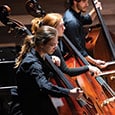The word tacet is Latin and translates to “it is silent”. Typically an orchestral musician encounters this word in their music when they do not play for an entire movement or more. Piccolo players frequently have to wait long periods of time for entrances, and then usually the entrance is a very exposed solo! Two infamous examples from the literature are Tchaikovsky’s Fourth Symphony and Beethoven’s Ninth Symphony.
The wait time from the beginning of the Beethoven to the first piccolo entrance is about 45 minutes. You sit through the first three movements and a good long portion of the fourth movement before the first entrance, which is the solo in the Turkish march section. This is followed by another fairly long wait until the exciting coda–the final five minutes of the work.
The Tchaikovsky tacet is only two movements long, but the solos that follow are high, technical, and legendary in their difficulty. Of course there are many other long rests sprinkled throughout the orchestral literature, not to mention ballet and operatic literature. Because piccolo is often an instrument that colors the ensemble, it is used sparingly in the orchestration. I’ve always liked to think of piccolo like a spice: a little garlic adds interest, too much can become real trouble!
When I face repertoire like this, I actually train in a slightly different way. Besides employing all the traditional careful practice methods that ensure technical proficiency, I use some specific practice methods tailored to the demands of a long tacet. These routines give me the confidence I need to play well.
On days when I am at home, I leave my piccolo out where it is clearly visible every time I walk by. I pick it up and practice the solos intermittently throughout the day as I go about other duties. The rational for this is, if I can execute a solo when I am not warmed up and after a three-hour tacet, then the normal wait of 30 minutes when I am ready to play will feel shorter and much more approachable. This is one way of specifically practicing for the task at hand.
In the orchestra before a big entrance, it is usually a good idea to double along quietly with on a short tutti passage in the second flute part before entering on the piccolo solo, just to make sure your pitch is matching the level of the group after your long rest. Be sure to double in the correct octave (you may need to play an octave lower than the second flute part is written) to match exactly. Be as unobtrusive as possible. This provides the opportunity to play a few notes before your big moment, which will give you extra confidence for the first entrance.
Relaxation Techniques
Reading
I think that there are some mental and physical relaxation techniques that can be helpful during performances that include long rests. Many players read magazines during tacets, especially when working in an orchestra pit. I find this a great tool at times; it keeps my mind engaged without too much distraction. However, reliable cues are absolutely necessary so that you never miss an entrance because you were reading.
I have seen players lose work because of sloppy behavior on the job. You can ask your colleagues to give you a cue and to check in with you during long rests. If you feel you might not be able to be alert enough, then simply never read in the pit. On the concert stage reading is really not an option. Our new hall includes audience seating behind the orchestra and on the sides as well. With the audience in full view of the musicians at all times and it is unacceptable to read on stage during any performance.
Visualization
I find that performance visualization is helpful during long rests. In the process of creating a mental image or intention of what I want to hear or feel, I become fully engaged in listening to my colleagues create music around me. This keeps me in the game so I don’t really feel like I’m ‘resting’. I become more ‘into’ the music and experience it as a participant, not a passive listener. I try to notice textures in the harmonic structure, counter melodies, new sounds in the familiar repertory. I decide how I want the performance to go: beautifully, (of course)!, and I use my preparation to help me achieve these results.
Imaging
Pitch and phrase imaging is also useful. Hear the phrase just as you want it to go just before you enter. Hear the first pitch and listen to the intervallic relationships of your solos as they relate to the other voices and harmonies. Pay attention and match the imagined aural image to the actual sound you produce.
Conversation
Affirming self-talk is very useful before particularly daunting moments, as in “I can do this, I’ve done it in practice many times before,” “I love how this solo sounds,” etc. By giving myself confidence I achieve a higher performance standard. The phrase “fake it till you make it” is a good one to remember here too: you will help yourself perform better with positive self-talk: tearing yourself down is counterproductive.
Breathing
Mental and physical relaxation is key to playing at your best. Practice inhaling slowly through the nose for four counts and exhaling slowly through the mouth for five. This kind of focused breathing gives you something to do and keeps your mind from wandering into the stress of the entrance. Your body enjoys the benefits of a lowered heart rate and increased oxygen at the same time. Feel your feet on the floor, notice how stable and calmly your body is held by the chair: focus on your relaxed and efficient posture.
Part of the experience of playing piccolo is learning how to handle the special job requirements of the chair. Tacets come with the territory: learn to enjoy them and make them work!





